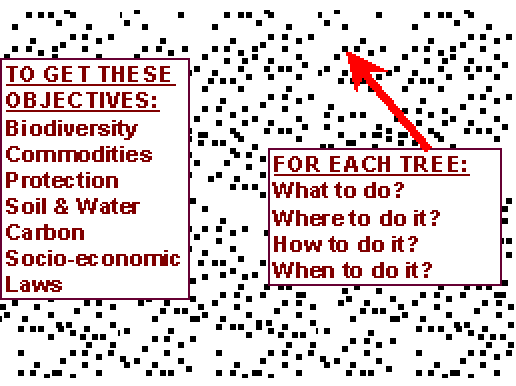
The Landscape Approach to Ecosystem Management
Different approaches to managing forests for commodity and non-commodity values have been proposed:
Landscape Approach (a.k.a. integrated management or structure-based management)
The landscape approach provides commodity and non-commodity values in the same forest area by using silvicultural operations to ensure that all stand structures (Figure 1, Figure 2) and other values are maintained across the landscape. In the process, timber is harvested to maintain or create stand structures; employment, access, fire protection, and other values are also provided. Both intensive plantations and reserves are possible within the context of the landscape approach to the extent that they help to maintain the balance of stand structures across the landscape as well as provide other values such as timber production and aesthetics.
Intensive
Plantations and Reserves
The intensive plantation/reserve approach segregates the forest into areas that provide different uses. Intensive plantations provide the wood fiber commodities, while reserves in which timber harvest is not allowed provide the non-commodity values such as biodiversity.
We believe that the landscape approach offers the greatest opportunity to meet the commonly-held goals of ecosystem management as defined by most people. In the following section we describe how the systems approach can be used to integrate ecosystems and forest management across a wide range of spatial and temporal scales--that is, how to apply the landscape approach. For differing opinions about these approaches, see Oliver 1992, 1999, Lippke and Oliver 1993, Carey et al. 1999 and http://greatrestoration.rockefeller.edu.
Applying the Systems Approach to Landscapes
The structure of a forest stand (Figure 1, Figure 2) is determined primarily by the spatial arrangement and the size and species distributions of trees. Because stand structure strongly dictates the presence of other plants and animals as well as the risk of certain disturbances such as fires, windthrow, and insect infestations, the focus of forest management has been largely on manipulating individual trees in a stand.

Managing at large spatial scales such as landscapes, watersheds, or regions requires making such operational decisions about millions and millions of trees. To approach such a problem without being overwhelmed by the complexity of the problem requires a conceptual framework that directly addresses the scale and complexity of the problem. The systems approach provides such a framework by grouping trees into stands, stands into landscapes, landscapes into watersheds, etc. in the form of a hierarchical system.
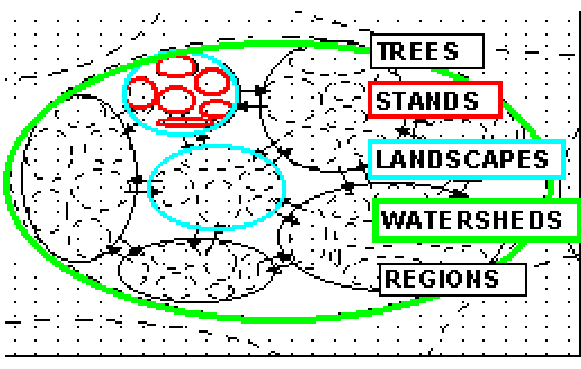
Scales
of Management within the Landscape Approach
Forest management ultimately involves managing individual trees;
however, to achieve some objectives, it is necessary to coordinate
management at other, higher levels.
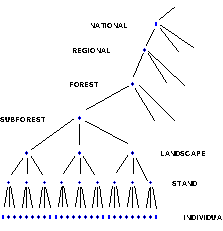
Different values, such as those of sustainable forestry (see Montreal Process Criteria), are achieved at different scales. For example, protecting biodiversity may be a regional- or global-scale forest management concern, while creating nesting habitat for a locally endangered bird species may be a stand- or landscape-scale management issue.
At the within-stand level, silvicultural operations such as harvesting, pruning, site preparation, prescribed burning, and planting are performed. These operations are short-term activities which directly influence individual trees within the stand.
At the stand level, silvicultural pathways (or regimes) are the set of unique changes in stand structure that occur over many decades and that arise from the interaction of growth, mortality, and recruitment of trees within the stand and the specific silvicultural operations that are applied to individual trees within the stand.
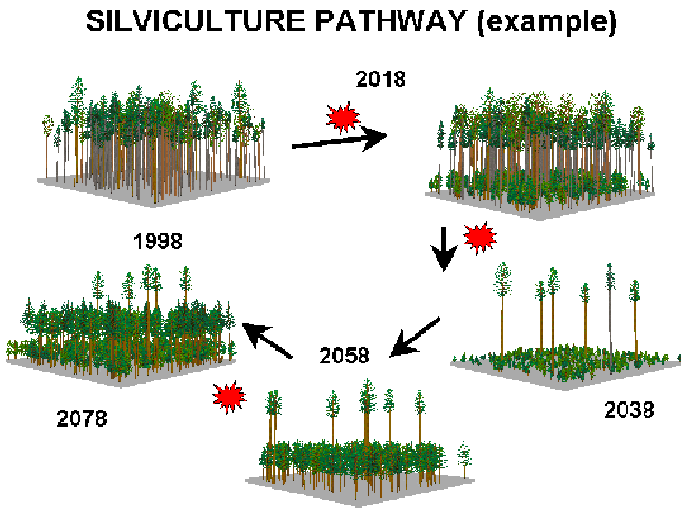
At the landscape level, different silvicultural pathways applied
to many stands determine landscape-scale patterns of forest structure
over time.
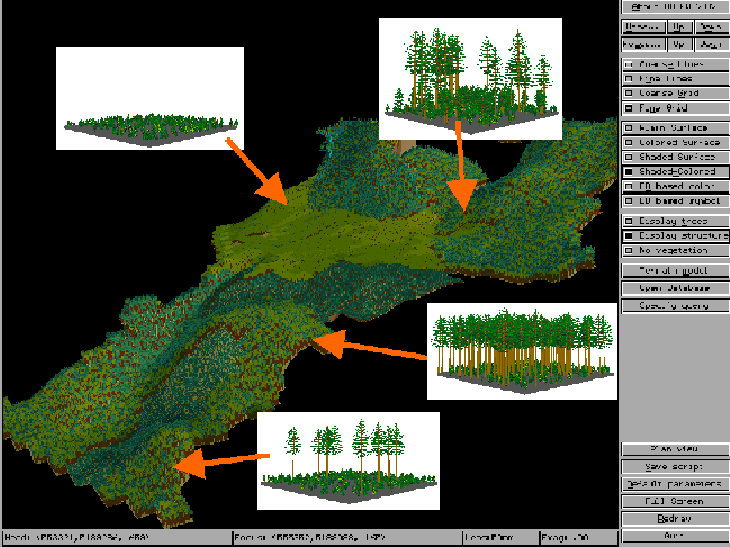
Considerable expertise is needed to know how to prescribe and implement the right silvicultural operation, silvicultural pathway, and landscape pattern to achieve the desired objectives. Many technical tools (e.g., LMS), research studies, professional meetings, and education and training courses aid the professional in making the appropriate prescriptions at each level.
Achieving objectives from forests necessitates managing both parallel
processes (e.g., red lines, below) and sequential processes (e.g.,
black lines) within the hierarchy of forest ecosystems.

Making precise plans at the upper levels of the management hierarchy
leads to confusion and conflict as the plans move to the lower
levels of the hierarchy (see Systems Theory: Hierarchies). Instead, objectives
expressed at higher levels should be general enough to allow for
the variation expected at more site-specific levels.
Example: Coarse Filter Biodiversity
Managing for biodiversity provides a good example of the systems
approach to achieving a management objective. In this instance
we are referring to the "coarse filter" approach to
protecting biodiversity--that is, maintaining certain amounts
of all habitat types at all times (cf. "fine filter"
approach which focuses on management of critical habitat for key
species). The table below shows one way approach to organizing
the different levels of the management hierarchy. At the highest
levels within the hierarchy, management objectives are general;
each lower level within the hierarchy has increasingly specific
management objectives. The lowest level, individual trees, is
where the operational decisions take place (e.g., which tree to
cut or leave, what species to plant). As can be seen, managing
and monitoring need to be done at many levels within the hierarchy
to ensure that management objectives are achieved across a wide
range of forest ecosystems.
| HIERARCHICAL LEVEL | OBJECTIVE |
| National | Coarse filter biodiversity |
| Regional | Habitats of species native to the region |
| Forest | Habitats of species specific to the forest |
| Watershed | Habitats native to the watershed |
| Landscape | Mixtures and distributions of stand structures that can be achieved within the planning period, based on current stand structures |
| Stand | Current and future stand structures that can be achieved within the planning period |
| Tree | Numbers, sizes, species, etc. of trees needed to provide targeted stand structure |